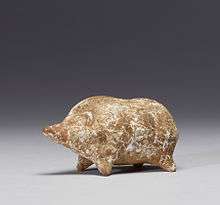Types of Women

Types of Women, sometimes translated simply as Women or rendered as Semonides 7, is an Archaic Greek satirical poem written by Semonides of Amorgos in the sixth or seventh century BCE. The poem is based on the idea that Zeus created men and women differently, and that he specifically created ten types of women based on different models from the natural world.[1] The poem survives due to its inclusion in the anthology of Joannes Stobaeus.[2]
Content
Of the ten types of women in the poem, nine are delineated as destructive: the dirty woman comes from a pig; the cunning woman originates from a fox, the incessantly curious and high-maintenance woman comes from a dog, the lazy or apathetic woman comes from earth or soil, the capricious woman of mood swings comes from seawater, the stubborn woman comes from an ass, the untrustworthy and uncontrollable woman comes from a weasel or skunk (depending on the translation), the overly proud woman comes from a mare, and the worst and ugliest type of woman comes from an ape or monkey.[3] Only the "Bee Woman" (who is dismissed as an impossible ideal) is regarded as virtuous. The bee reference is considered homage to the earlier poem of Hesiod entitled Theogony, which uses the metaphor of women and men as bees in one part.[4]
Significance
The poem, fragment 7 of Semonides, is notable for its length.[5] At 118 lines, it is the longest surviving example of early Greek iambic poetry. Along with Hesiod's telling of the story of Pandora, it is one of the earliest texts attesting to the misogyny in ancient Greek thought.[6]
The poem was probably written for sympotic performance. It is seen by Robin Osborne as an attempt to reinforce male power structures, which "depended on, and [were] constantly reinforced by, [the] abuse of women".[5] Theresa Morgan notes, though, that despite the fact that the poem echoes patriarchal power-structures, men in the poem have surprisingly little control over their wives, who are able to misbehave in all the ways attributed to them in the poem.[7]
It has generally been received poorly by modern authors, who have described it as "pretty well wihout wit and lacking in charm of presentation".[8] While it has been considered important as an insight into archaic modes of thought, critics such as Hermann Fränkel, have claimed that it has little literary value.[8] Hugh Lloyd-Jones agrees that Semonides is not a "great poet", unlike his contemporary Archilochus,[9] though Pat Easterling defends it as being "a lively and interesting poem" with "vivid use of everyday detail". Even Easterling however concludes that the poem is "intellectually undemanding".[10]
References
- ↑ Joy, Morny (2013). Women and the Gift: Beyond the Given and All-Giving. Indiana University Press. p. 64.
- ↑ Lloyd-Jones, Hugh. Females of the Species: Semonides on Women. p. 102. ISBN 0715608843.
- ↑ Lefkowitz, Mary R. (1997). "Review of 'Females of the Species: Semonides on Women' by Hugh Lloyd-Jones". Signs. 2 (3): 690–92. doi:10.1086/493398. Retrieved 8 October 2015.
- ↑ Peradotto, John; Sullivan, John Patrick (1984). Women in the Ancient World: The Arethusa Papers. SUNY Press. p. 46.
- 1 2 Osborne, Robin (January 2001). "The Use of Abuse: Semonides 7". The Cambridge Classical Journal. 47: 47–64. doi:10.1017/S0068673500000699.
- ↑ North, Helen (1977). "The Mare, the Vixen, and the Bee: Sophrosyne as the virtue of women in antiquity". Illinois Classical Studies. 2: 36.
- ↑ Morgan, Theresa (January 2005). "The Wisdom of Semonides Fragment 7". The Cambridge Classical Journal. 51: 72–85. doi:10.1017/S1750270500000403.
- 1 2 Lloyd-Jones, Hugh. Females of the Species: Semonides on Women. p. 22. ISBN 0715608843.
- ↑ Lloyd-Jones, Hugh. Females of the Species: Semonides on Women. p. 24. ISBN 0715608843.
- ↑ Easterling; Knox. The Cambridge History of Classical Literature Volume I: Greek Literature.
External links
- Translation of the poem at Michigan State University
- Alternative translation by Diane Arnson Svarlien